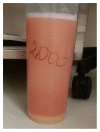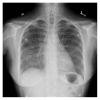Rare Presentation of Pulmonary Alveolar Proteinosis Causing Acute Respiratory Failure
- PMID: 27445536
- PMCID: PMC4904544
- DOI: 10.1155/2016/4064539
Rare Presentation of Pulmonary Alveolar Proteinosis Causing Acute Respiratory Failure
Abstract
Pulmonary alveolar proteinosis (PAP) is a rare condition characterized by dysfunctional alveolar macrophages, which ineffectively clear surfactant and typically cause mild hypoxemia. Characteristic Computed Tomography findings are septal reticulations superimposed on ground-glass opacities in a crazy paving pattern, with a clear juxtaposition between affected and unaffected parenchyma. While traditionally PAP was diagnosed via biopsy, bronchoalveolar lavage (BAL) is usually sufficient; the fluid appears milky, and on microscopic examination there are foamy macrophages with eosinophilic granules and extracellular hyaline material that is Periodic Acid-Schiff positive. Standard therapy is whole lung lavage (WLL), although novel treatments are under development. The case presented is a 55-year-old woman with six months of progressive dyspnea, who developed hypoxemic respiratory failure requiring mechanical ventilation; she had typical findings of PAP on imaging and BAL. WLL was ultimately successful in restoring adequate oxygenation. Respiratory failure of this magnitude is a rare finding in PAP.
Figures






Similar articles
-
Combined-modality therapy for pulmonary alveolar proteinosis in a remote setting: a case report.BMC Pulm Med. 2019 Mar 12;19(1):61. doi: 10.1186/s12890-019-0822-x. BMC Pulm Med. 2019. PMID: 30866900 Free PMC article.
-
Atypical image of pulmonary alveolar proteinosis - a case report.Pneumonol Alergol Pol. 2015;83(6):453-6. doi: 10.5603/PiAP.2015.0074. Pneumonol Alergol Pol. 2015. PMID: 26559798
-
Case series of rare Interstitial Lung Disease (ILD).J Pak Med Assoc. 2017 May;67(5):802-805. J Pak Med Assoc. 2017. PMID: 28507378
-
From the archives of the AFIP: pulmonary alveolar proteinosis.Radiographics. 2008 May-Jun;28(3):883-99; quiz 915. doi: 10.1148/rg.283075219. Radiographics. 2008. PMID: 18480490 Review.
-
Pulmonary alveolar proteinosis: an overview for internists and hospital physicians.Hosp Pract (1995). 2010 Feb;38(1):43-9. doi: 10.3810/hp.2010.02.277. Hosp Pract (1995). 2010. PMID: 20469623 Review.
Cited by
-
Mimickers of novel coronavirus disease 2019 (COVID-19) on chest CT: spectrum of CT and clinical features.Insights Imaging. 2021 Feb 3;12(1):12. doi: 10.1186/s13244-020-00956-6. Insights Imaging. 2021. PMID: 33533965 Free PMC article. Review.
References
-
- Cohen E. S., Elpern E., Silver M. R. Pulmonary alveolar proteinosis causing severe hypoxemic respiratory failure treated with sequential whole-lung lavage utilizing venovenous extracorporeal membrane oxygenation: a case report and review. Chest. 2001;120(3):1024–1026. doi: 10.1378/chest.120.3.1024. - DOI - PubMed
Publication types
MeSH terms
LinkOut - more resources
Full Text Sources
Other Literature Sources
Medical
Research Materials

